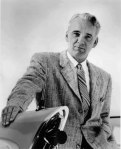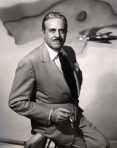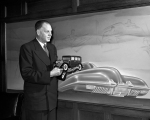Auto Designers of the 50s
Men like Virgil Exner, a dynamic young designer at Chrysler, were the moving force behind the innovative designs and styling that became popular during the decade. Other 1950s automobile designers to become household names included Harley Earl of General Motors who is credited with pioneering the tail fin that became inexorably linked with classic cars of the 1950s.
Perhaps the most famous name associated with automobile design during the 1950s was Raymond Loewy. Known as the ‘Father of Industrial Design’ he designed the Studebaker Starliner Coupé, which the Museum of Modern Art later called a “work of art.” Of course not all 1950s automobile designers achieved such fame as enjoyed by the three men above but countless others contributed to the wealth of incredible car designs that graced the roads of America in the golden era of automobile engineering and styling.
But, unfortunately, just as there is good there is always bad. And even the iconic 50s had its share of motorised turkeys. Perhaps the biggest of them all was the notorious Ford Edsel. It was truly a donkey amongst thoroughbreds.
Named after Henry Ford’s son the Edsel was launched with a budget claimed to be in excess of $200 million. Production lasted just three years, ceasing in 1959, as the public turned its back on the cars ugly looks and sky high price tag. But the Edsel gained its real notoriety through the unfortunate styling of its horse-collar grille which bore more than a passing resemblance to a certain part of the female anatomy!
But, the odd turkey apart, the 1950s automobile designers got it right most of the time and produced a range of motor cars that are the essence of good design.
He heralded a great era of car creation when he joined Chrysler in 1949. He was to remain with Chrysler for the next 12 years.
Exner based his concept of design on the “idea car” and his first “idea for Chrysler came with the launch of the K-310 in 1950.
Crucial to the ideal car concept was that elements of the car that were functional, such as tail lights, wheels, radiator grills were to be shown rather then kept hidden from view.
After the K-310 was introduced to the car buying public, Exner was then responsible for the design of revolutionary Hemi V1 in 1951. His skill as a designer also saw him quickly promoted up the Chrysler hierarchy.
By 1953 he was the Chrysler director of styling. Four years later he became the company’s vice president of styling, the first time that Chrysler had created such a position.
He also continually refined his designs, producing some of the most innovative work in the car industry.
By the mid 1950s Exner was seeking to include more prominent tail fins in his designs, creating the Flight Sweep I and II to help him achieve this.
In 1955 he furthered developed the concept of the “idea car” by designing the Chrysler Falcon.
The Falcon was a sports convertible in which the radiator grill was prominent and the side exhaust exposed.
In 1957 Exner demonstrated his skill in car design when the Imperial launched, the first American made car to have curved glass in the side windows – a concept which was to be copied by other car manufacturers.
Raymond Loewy
Raymond Loewy is one of the leading designers associated with 1950s automobiles.
Hailed as the father of industrial design, French born Raymond Loewy dedicated his talents to the American motor car manufacturing industry after Studebaker recruited his company Loewy and Associates to aid the design of their cars in 1936.
Three years later Loewy began work with Studebaker’s lead designer Virgil Exner, another dean of American car design.
Following the ending of World War Two, the American car industry had a renaissance as sales rocketed. Loewy had a role in incorporating the new designs which were to be so tempting to the car buying public.
Loewy and his creative team designed the iconic bullet nosed Studebaker cars of the early 1950s. In 1953, in collaboration with Virgil, Loewy created the Starliner and Starlight coupés, which were part of the 1953 Studebaker line.
Twenty tears later the Starliner coupé was hailed as an “industry best” by the United States top motor car designers.
In the mid 1950s Loewy transformed the Starliner and Starlight into the Hawk range.
That was to be Loewy’s final project for the company, but in the early 1960s he was brought back by Studebaker for the design of the Avanti.
Outside the world of car manufacture, Loewy design skills proved to be most versatile. In 1939 he redesigned the packaging for the Lucky Strike brand of American cigarettes.
In 1952 he founded the Compagnie de I’Esthetique Industrielle in his native France and two years later designed what was to become the Greyhound Bus.
And in 1962 he designed the Shell logo, one of the most recognisable brands on the planet.
Harley Earl
Harley Earl, who died in 1969 at the age of 75, was one of the motor industries most prominent stylist, engineer and designers.
His work in the industry earned him the tag “ the Da Vinci of Detroit,” such was his known in America’s capital of car manufacture.
Earl firmly believe that design was crucial if a particular make of car was going to make its mark in the market place. In 1956 he said: “The art of automobile design has progressed, until today it is regarded as one of the most important factors in the marketing of the automobile.”
Harley’s achievements in the car manufacturing were plenty, but what earned him true public renown was his development of the tailfin. The tailfin was synonymous with motor car style and design during the 1950s and it continued through into the 60s.
The tailfin on cars such as the Buick Lesabre – one of Earl’s “concept cars” -are held to have helped car sales rocket during the 1950s.
And a report from the California Institute of Technology found that tailfins on certain models helped improve high speed road holding.
But the development of the tailfin was not Earl’s only contribution to the American motor industry.
He introduced the concept of annual design changes, some which helped tempt the motor enthusiast in to the car showrooms.
His innovations also saw the introduction of wrap around windscreens, chrome and two tone paint, as synonymous of the 1950s car as the tailfin.
In 2002 General Motors commemorated Earl’s contribution to car design in a series of commercials which featured the actor John Diehl saying: “My name is Harley Earl,and I’ve come back to sell you a Buick.”


